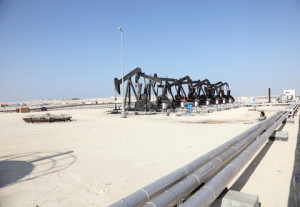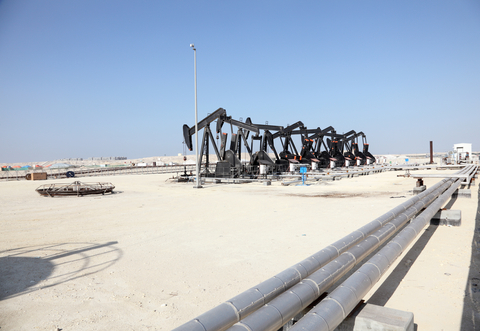Commentary – It’s a Price War…Still

Oil pump jacks in the Middle East.
Source: www.dreamstime.com © Typhoonski
Many people ask me, “Why doesn’t Saudi Arabia cut production to help boost prices?”
I almost always pause, knowing there isn’t a quick black-and-white answer. So hedging my knowledge, I reply, “While anything is possible, the likelihood of a cut occurring is slim.”
November 27th marks the one year anniversary since Saudi Arabia made the watershed decision to pivot from protecting oil price to maximizing market share. In a matter of weeks the members of the cartel will meet again, to ponder if they should stay the course on the decision made last year, or intervene in what is proving to be the greatest oil market downturn in decades.
Making-up a third of all OPEC production, Saudi Arabia is the most significant player. The main argument for why Riyadh would rein in its production is because the math works: If Saudi Arabia were to drop its production by 1.5 million barrels per day, and the oil price jumped up $20 per barrel as a result, then the Kingdom’s oil revenue would increase by approximately 30 percent. But it is debatable if Riyadh needs the money. Even though the Kingdom is on track for a $100 Billion deficit this year, they still have more than $600 Billion in treasury. The IMF expects that the Saudis could overspend at the current rate for five more years before exhausting their giant piggy bank. Considering that the country’s finances are manageable, a solo production cut that would ultimately shrink their market share seems unlikely.
The crude oil price war has been waging since last November. In the January 2015, ARC Energy Charts commentary titled “Two-for-one Pizzas, One-Dollar Airline Tickets and $40 Oil”, Peter Tertzakian identified that the stage was set for a price war. Pointing out that, “producers tend to produce even more when price first falls, because they try to offset revenue loss by boosting output.”
According to the IEA, between November 2014 and October of this year, Saudi Arabia and Iraq have both increased their production by close to 800,000 barrels per day. Russia is currently pumping out 170,000 barrels per day more than last November. Even in the United States, where oil drilling rates are more than 60 percent below 2014 levels, crude oil production is still 350,000 barrels per day higher than last November.
The price war is not over. Within six months of lifting the sanctions, the Iranian oil minister expects Iran will pump out an additional one million barrels per day. That’s convincing in theory, but reinvigorating Iranian production will require billions of dollars of investment and time. That is why most oil analysts doubt that Iranian production will reach their claimed, lofty levels next year.
Considering Iran’s position, it is hard to imagine OPEC negotiating a collective cut this December. Saudi Arabia will not want to cut its production only to concede market share to its long term rival Iran. In fact, it is more probable that the comeback of Iran, even in small measure, will extend the price war, causing other producers to push up their production even higher in an effort to maintain market share.
Wars in Syria and Yemen are another reason that a collective agreement is unlikely. While both countries do not produce much oil, the wars have put major oil exporting countries into military conflict. In Yemen, Saudi Arabia is fighting the Iranian backed Houthi and in Syria, Iran and Russia are backing the Assad regime, while the Arab Gulf states are supporting the opposition. It is hard to see how these countries, in the midst of a real war, could make a collective pact to reduce oil production.
Finally, there is the matter of US tight oil. While the pace of production has slowed, US tight oil is proving to be robust in the face of low price. Arguably, the past year has made tight oil an even more formidable competitor. The downturn has reduced the costs for development, and it now seems plausible that the United States could add production when the price of oil reaches $60 or $65 per barrel. Assuming that Saudi Arabia were to make a production cut, the higher oil price could result in a surge of tight oil production that would quickly consume the market share that the Kingdom gave up.
With Iran’s production level unknown, the threat of US tight oil growth at higher price levels, and the reality that major oil exporters are locked in price and military wars, a production cut by OPEC in December is unlikely. However, all wars must eventually come to an end. At some point, the damage will become too much, forcing a truce. But for now the price war rages on.


